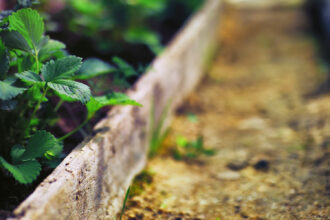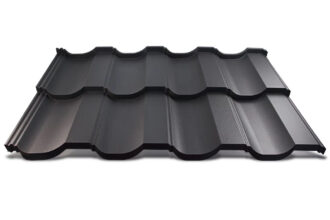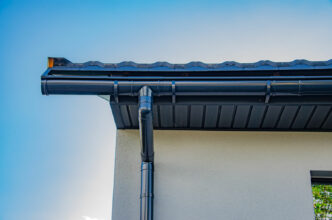Eaves are one of the structural elements of a roof. It is the part that extends beyond the contours of the house. It might seem that a roof without eaves would be out of the question. In fact, buildings with eaves-free roofs have not only been built for a long time, but are also becoming increasingly popular. Check out the strengths and weaknesses of an eavesless roof and decide if it is the solution for you!
Roof eaves – what are they?
The roof eaves are the lower edge of the roof surface that extends beyond the external walls of the building. What does it do besides decorate?
- Drains rainwater.
- Protects the facade against moisture.
- Provides ventilation in the space under the canopy cover.
- It protects windows and the building façade from the damaging effects of rain and hail.
- It shields the building from intense sunlight. This allows the rooms inside the property to heat up more slowly.
Disadvantages of roof eaves
Building, installing and securing roof eaves requires expert knowledge and experience. This structural element of the roof is quite a challenge, even for a skilled roofer. Above all, the eaves are exposed to moisture. Even minor installation shortcomings and faults can cause water to penetrate under the roof covering. This, in turn, has a destructive effect on the roof trusses and the inner layers of the roofing. The costs of repairing or replacing these elements, particularly the trusses, are very high.
Rodents, small birds or vermin can also enter through gaps in the eaves. If they settle under the roof structures, their removal can be very problematic. This space, therefore, requires additional protection in the form of ridges and nets, which of course, entails further expense and an increase in the duration of the roof work. In addition, the eaves can significantly reduce the amount of daylight reaching the rooms in the building.
Eavesless roof construction and drainage
The rafters in an eavesless roof end directly at the wall. This construction means the eaves board must be attached to the rafter’s face. In this case, a gutter strip serves as a rain protection element for the facade. If you opt for a roof without eaves, you can also use the classic arrangement of gutters and downpipes. In this case, they must be fixed along the roof edge line.
An alternative solution is to suspend the gutters on the wall below the roof edge line. If you opt for this option, ensure that the external walls of the buildings are adequately protected, e.g. by cladding.
A popular solution in the absence of eaves is to cover the roof and sections of the façade with the same material. This allows you to dispense with the installation of a gutter system altogether. In this case, proper roof drainage plays a key role. Otherwise, water running off the slope can damage it.
Which gutter should I choose for an eavesless roof?
A gutter for a roof without eaves should be very robust and durable. It is, therefore, advisable to choose galvanised steel, copper or high-quality aluminium models. In the case of an eavesless roof, gutters with a square cross-section are best suited. This is due to their capacity, which is greater than that of half-round variants.
Eaveless Roofs – are they worth it?
Eavesless roofs have many advantages, but they are far less common in Poland than classic eaves roofs. This solution is particularly appreciated by architects and fans of modern building blocks in which minimalism plays the leading role. A roof without eaves is undoubtedly an eye-catcher. However, the visual aspect is not all it has to offer. What other benefits does this type of roofing offer?
- It requires less work than a complex eaves roof structure, resulting in a lower investment cost.
- It increases the energy efficiency of the building. This is because a roof without eaves significantly reduces the risk of leaks. These are the main cause of heat escaping outside the property, leading to higher electricity bills.
- It exposes the windows, thereby increasing the sun’s input. This is particularly important for dense buildings and structures surrounded by tall trees.
Importantly, it would be best if you decided on installing an eaves-free roof at the design stage of the building. The roof must be in harmony with the overall design. Otherwise, the visual effect can be severely disappointing, and the roof cost is disproportionately high.
Roof without canopy – optional accessories
If you opt for an eaveless roof, remember the accessories that will protect the property. The most critical elements in this case include:
- heaters inside the gutters – help to ensure that the structure is unobstructed, especially in icy conditions;
- Roller blinds or awnings – to protect the building from excessive sunlight and thus overheating;
- waterproof facade materials;
Cost of roof without eaves
As with traditional roofing, the final cost of a roof without eaves depends on several variable factors. Key factors in this context include the size of the roof, the material it will be made of and its shape. In most cases, an eaveless roof costs less than a structure with eaves. This is mainly because the roofer has less work to do.
Roof insulation without eaves
The correct drainage installation is one of the most critical steps in insulating an eavesless roof. It might seem that the two aspects are entirely separate, but proper drainage is closely linked to maintaining the building’s thermal insulation. Mistakes made at this stage can result in the insulation failing to do its job as moisture enters.
Choose hygroscopic cellulose thermal insulation if you decide to cover your eavesless roof with roofing felt. This material effectively accumulates excess water vapour while retaining thermal insulation properties.
Are you looking for a durable and aesthetically-pleasing roofing material that won’t strain your budget? Choose solid metal roofing tiles! In our offer you will find modern materials in a range of colours, which will not only decorate but also protect your roof.


